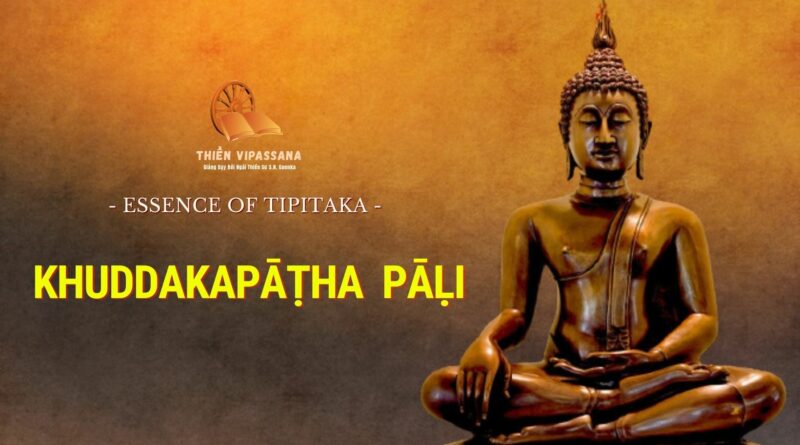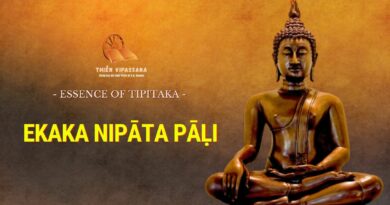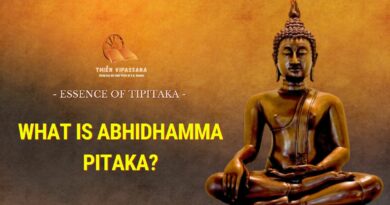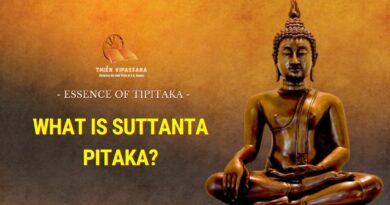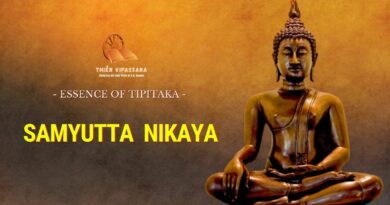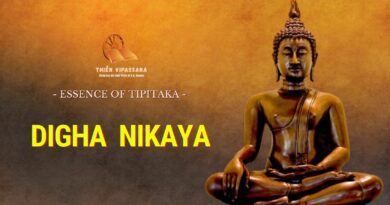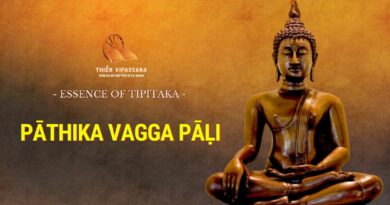1 Khuddakapāṭha Pāḷi
First of the treatises in this nikāya, Khuddakapāṭha contains “readings of minor passages” most of which are also found in other parts of the Tipiṭaka. It is a collection of nine short formulae and the suttas used as a manual for novices under training, namely: (a) The Three Refuges; (b) The ten precepts; (c) The thirty-two parts of the body; (d) simple Dhamma for novices in the form of a catechism; (e) Maṅgala Sutta; (f) Ratana Sutta; (g) Tirokuṭṭa Sutta; (h) Nidhikaṇḍa Sutta; (i) Mettā Sutta.
Taking refuge in the Three Gems: the Buddha, the Dhamma and the Sangha, by reciting the formulae, “I take refuge in the Buddha, I take refuge in the Dhamma, I take refuge in the Sangha,” is a conscious act of expression of complete faith in the Three Gems, not mere profession of superficial belief nor a rite of traditional piety. It implies (i) one’s humility; (ii) one’s acceptance of the Three Gems as one’s guiding principles and ideals; (iii) acceptance of discipleship and (iv) homage.
In the section on Kumāra pañha, questions for young boys, the Dhamma is tailored to suit the young intellect of the novices:
What is the one?
-The nutrient which sustains the life of the beings.
What are the two?
–Nāma and rūpa.
What are the three?
-pleasant, unpleasant, neutral vedanās.
What are the four?
-The Four Noble Truths.
What are the five?
-The five groups of grasping.
What are the six?
-The six bases of senses.
What are the seven?
-The seven factors of enlightenment.
What are the eight?
-The Noble Path of Eight Constituents.
What are the nine?
-The nine abodes or types of beings.
What are the ten?
-The ten demeritorious courses of action.
Mahā Maṅgala Sutta, the discourse on the great blessings, is a famous sutta, cherished highly in all Buddhist countries. It is a comprehensive summary of Buddhist ethics for the individual as well as for the society, composed in elegant verses. The thirty-eight blessings enumerated in the sutta as unfailing guides throughout one’s life start with advice on “avoidance of bad company” and provides ideals and practices basic to all moral and spiritual progress, for the welfare and happiness of the individual, the family and the community. The final blessing is on the development of the mind which is unruffled by the vagaries of fortune, unaffected by sorrow, cleansed of defilements and which thus gains liberation-the mind of an arahat.
The Ratana Sutta was delivered by the Buddha when Vesāli was plagued by famine, disease, etc. He had been requested by the Licchavi princes to come from Rājagaha countering the plagues, by invocation of the truth of the special qualities of the Three Gems: the Buddha, the Dhamma and the Sangha.
The Mettā Sutta was taught to a group of bhikkhus who were troubled by non-human beings while sitting in meditation at the foot of secluded forest trees. The Buddha showed them how to develop loving-kindness towards all beings, the practice which will not only protect them from harm but will also serve as a basis for insight through attainment of jhāna.
The Khuddakapāṭha which is a collection of these nine formulae and suttas appeared to be arranged in such a way as to form a continuous theme demonstrating the practice of the holy life: how a person accepts the Buddha’s teaching by taking the refuge in the Three Gems; then how he observes the ten precepts for moral purification. Next he takes up a meditation subject, the contemplation of thirty-two constituents of the body, to develop non-attachment. He is shown next the virtues and merits of giving and how one handicaps oneself by not performing acts of merit. In the meanwhile he safeguards himself by reciting the Maṅgala Sutta and provides protection to others by reciting the Ratana Sutta. Finally, he develops loving-kindness towards all beings, thereby keeping himself safe from harm; at the same time he achieves jhānaconcentration which will eventually lead him to reach the goal of spiritual life, nibbāna, by means of knowledge of insight and the path.
2 The Dhammapada Pāḷi
It is a book of the Tipiṭaka which is popular and well-known not only in the Buddhist countries but also elsewhere. The Dhammapada is a collection of the Buddha’s words or basic and essential principles of the Buddha’s teaching. It consists of 423 verses arranged according to the topics in twenty-six vaggas or chapters.
Verse 183 gives the teachings of the Buddha in a nutshell: abstain from all evil; promote (develop) what is good and purify your mind. Each stanza is packed with the essence of truth which illumines the path of a wayfarer. Many are the Dhammapada verses which find their way into the writings and everyday speech of the Buddhists. One can get much sustenance and encouragement from the Dhammapada not only for spiritual development but also for everyday living.
The Dhammapada describes the path which a wayfarer should follow. It states (in verses 277, 278 & 279) that all conditioned things are transitory and impermanent; that all conditioned things are subject to suffering; and that all things (dhammas) are insubstantial, incapable of being called one’s own. When one sees the real nature of things with Vipassana insight, one becomes disillusioned with the charms and attractions of the five aggregates. Such dillusionment constitutes the path of purity (nibbāna).
Verse 243 defines the highest form of impurity as ignorance (avijjā) and states that the suffering in the world can be brought to an end only by the destruction of craving or hankering after sensual pleasures. Greed, ill will and ignorance are described to be as dangerous as fire and unless they are held under restraint, a happy life is impossible both now and thereafter.
Avoiding the two extremes, namely, indulgence in a life of sensual pleasure and the practice of self-mortification, one must follow the middle path, the Noble Path of Eight Constituents, to attain perfect peace, nibbāna. Attainment of the lowest stage (sotāpatti magga) on this path shown by the Buddha is to be preferred even to the possession of the whole world (V.178). The Dhammapada emphasizes that one makes or mars oneself, and no one else can help one to rid oneself of impurity. Even the Buddhas cannot render help; they can only show the way and guide; a man must strive for himself.
The Dhammapada recommends a life of peace and non-violence and points out the eternal law that hatred does not cease by hatred, enmity is never overcome by enmity but only by kindness and love (V.5). It advises one to conquer anger by loving-kindness, evil by good, miserliness by generosity, and falsehood by truth.
The Dhammapada contains gems of literary excellence, filled with appropriate similes and universal truths and is thus appealing and edifying to readers all over the world. It serves as a digest of the essential principles and features of the Buddha Dhamma as well as the wisdom of all ages.
3 Udāna Pāḷi
An udāna is an utterance mostly in verse form inspired by a particularly intense emotion. This treatise is a collection of eighty joyful utterances made by the Buddha on unique occasions of sheer bliss; each udānain verse is accompanied by an account in prose of the circumstances that led to its being uttered.
For example in the first Bodhivagga Sutta are recorded the first words spoken aloud by the newly enlightened Buddha in three stanzas beginning with the famous opening lines: “yadā have pātubhavanti dhammā, ātāpino jhāyato brāhmaṇassa.”
For seven days after his enlightenment, the Buddha sat at the foot of the Bodhi tree feeling the bliss of liberation. At the end of seven days he emerged from this phala samāpatti (sustained absorption in fruition-mind), to deliberate upon the principle of Dependent Origination: When this is, that is (imasmiṃ sati, idaṃ hoti); this having arisen, that arises(imassuppāda, idaṃ uppajjati); when this is not, that is not (imasmiṃ asati, idaṃ na hoti); this having ceased, that ceases (imassa nirodhā, idaṃ nirujjhati).
In the first watch of the night, when the principle of the origin of the whole mass of suffering was thoroughly grasped in a detailed manner in the order of arising, the Buddha uttered this first stanza of joy:
“When the real nature of things becomes clear to the ardently meditating recluse, then all his doubts vanish, because he understands what that nature is as well as its cause.”
In the second watch of the night, his mind was occupied with the principle of Dependent Origination in the order of ceasing. When the manner of cessation of suffering was thoroughly understood, the Buddha was moved again to utter a second stanza of jubilation:
“When the real nature of things becomes clear to the ardently meditating recluse, then like the sun that illumines the sky, he stands repelling the dark hosts of māra.“
4 Itivuttaka Pāḷi
The fourth treatise contains 112 suttas divided into four nipātas with verses and prose mixed, one supplementing the other. Although the collections contain the inspired sayings of the Buddha as in udāna, each passage is preceded by the phrase, “iti vuttaṃ bhagavata” (“thus was said by the Buddha”), and reads like a personal notebook in which are recorded short pithy sayings of the Buddha.
The division into nipātas instead of vaggas denotes that the collection is classified in ascending numerical order of the categories of the Dhamma as in the nipātas of the Aṅguttara. Thus in Ekaka Nipāta are passages dealing with single items of the Dhamma: “Bhikkhus, abandon craving; I guarantee attainment of the state of an anāgāmi if you abandon craving.” In Duka Nipāta each passage deals with units of two items of the Dhamma: there are two forms of nibbāna dhātu,namely, sa-upādisesa nibbāna dhātu, with the five khandhas still remaining, and anupādisesa nibbāna dhātu, without any khandharemaining.
5 Suttanipāta Pāḷi
As well-known as Dhammapada, Sutta Nipāta is also a work in verse with occasional introduction in prose. It is divided into five vaggas: (i) Uraga Vagga of twelve suttas; (ii) Cūḷa Vagga of fourteen suttas; (iii) Mahā Vagga of twelve suttas; (iv) Aṭṭhaka Vagga of sixteen suttas; (v) Pārāyana Vagga of sixteen questions.
In the twelve suttas of the Uraga Vagga are found some important teachings of the Buddha which may be practised in the course of one’s daily life:
“True friends are rare to come by these days; a show of friendship very often hides some private ends. Man’s mind is defiled by self-interest, so, becoming disillusioned, he roams alone like a rhinoceros.”(Khaggavisāna Sutta)
“Not by birth does one become an outcast, not by birth does one become a brāhmaṇa”;
By one’s action one becomes an outcast, by one’s action one becomes a brāhmaṇa. (Vasala Sutta)
“As a mother even with her life protects her only child, so let one cultivate immeasurable loving-kindness towards all living beings.”(Mettā Sutta)
Pārāyana Vagga deals with sixteen questions asked by sixteen brahmin youths while the Buddha is staying at Pāsānaka shrine in the country of Magadha. The Buddha gives his answers to each of the questions asked by the youths. Knowing the meaning of each question and that of the answer given by the Buddha, if one practises the Dhamma as instructed in this sutta, one can surely reach the other shore, which is free from ageing and death. The Dhamma in this sutta is known as pārāyana. (Vasala Sutta)
6 Vimāna Vatthu Pāḷi
Vimāna means mansion. Here it refers to celestial mansions gained by beings who have done acts of merit. In this text are eighty-five verses grouped in seven vaggas. In the first four vaggas, celestial females give an account of the acts of merit they have performed in previous existences as human beings and of their rebirth in deva realms where magnificent mansions await their appearance. In the last three vaggasthe celestial males tell their stories.
The Venerable Mahā Mogallāna, who could visit the deva realm, brought back stories as told to him by the devas concerned and recounted them to the Buddha who confirmed the stories by supplying more background details to them. These discourses were given with a view to bring out the fact that the human world offers plenty of opportunities for performing meritorious acts. The objective for such discourses was is to refute the wrong views of those who believe that nothing exists after this life (the annihilationists) and those who maintain that there is no resultant effect to any action.
Of the eighty-five stories described, five stories concern those who have been reborn in the deva world having developed themselves to the stage of the sotāpanna in their previous existences; two stories on those who have paid homage to the Buddha with clasped hands; one on those who had expressed words of jubilation at the ceremony of building a monastery for the Sangha; two stories on those who have observed the moral precepts; two stories on those who have observed the precepts and given alms; and the rest deal with those who have been reborn in the deva world as the wholesome result of giving alms only.
The vivid accounts of the lives of the devas in various deva abodes serve to show clearly that the higher beings are not immortals, nor creators, but are also evolved conditioned by the result of their previous meritorious deeds. They too are subject to the laws of anicca, dukkha and anattā and have to strive themselves to achieve the deathless state of nibbāna.
7 Peta Vatthu Pāḷi
The stories of petas are graphic accounts of the miserable beings who have been reborn in unhappy existences as a consequence of their evil deeds. There are fifty-one stories divided into four vaggas, describing the life of misery of the evil doers, in direct contrast to the magnificent life of the devas.
Emphasis is again laid on the beneficial effects of giving; whereas envy, jealousy, miserliness, greed and wrong views are shown to be the causes of ones appearance in the unhappy world of the petas. The chief suffering in this state is the severe lack of food, clothing and dwelling places for the condemned being. A certain and immediate release from such miseries can be given to the unfortunate being if his former relatives perform meritorious deeds and share their merits with him. In Tirokuttapeta Vatthu, a detailed account is given on how King Bimbisāra brings relief to his former relatives who are unfortunately suffering as petas by making generous offerings of food, clothing and dwelling places to the Buddha and his company of bhikkhus and sharing the merit thus accrued with the petas who have been his kith and kin in previous lives.
8 The Thera Gāthā Pāḷi and
9 The Therī Gāthā Pāḷi
These two treatises form a compilation of delightful verses uttered by some two hundred and sixty-four theras and seventy-three therīsthrough sheer exultation and joy that arose out of their religious devotion and inspiration. These inspiring verses gush forth from the hearts of bhikkhus and bhikkhunis after their attainment of arahatship as an announcement of their achievement and also as statement of the effort which has led to their final enlightenment.
It may be learnt from these jubilant verses how a trifling incident in life, a trivial circumstance, can become the starting point of spiritual effort which culminates in the supreme liberation. But for some of the therasthe call came early to them to forsake the homelife and take to the life of the homeless recluse. Their struggle was hard because of the inner fight between the forces of good and evil. They had a good fight and they have won by virtue of their resolution and ardent determination. The crippling bonds of greed, hatred and ignorance have been broken asunder and they are freed. In sheer exultation, they utter forth these inspiring verses proclaiming their freedom and victory. Some of thesetheras reach the sublime height of poetic beauty when they recount their solitary life in the quiet glades and groves of the forest, the beauteous nature that surrounds them, and the peace and calm that has facilitated their meditation.
Although the verses in the Therī Gāthā lack the poetic excellence and impassioned expression of love of solitude that characterize the verses in the Thera Gāthā, they nevertheless reflect the great piety and unflinching resolution with which the therīs have struggled to reach the goal. One distinguishing feature of the struggle of the therīs is that many of them receive the final impetus to seek solace in holy life through an emotional imbalance they have been subject to, for example, loss of the dear one as in the case of Paṭācārā, or through intense personal suffering over the death of a beloved son as suffered by Kisā Gotamī.
Both the Thera Gāthā and the Therī Gāthā provide us with shining, inspiring models of experience, so consoling and so uplifting, so human and true to life, leading us on to the path of the holy life, stimulating us when our spirit drops, our mind flags, and guiding us through internal conflicts and set-backs.
These gāthās may be enjoyed simply as beautiful poems with exquisite imagery and pleasing words or they may be contemplated on as inspiring messages with deep meaning to uplift the mind to the highest levels of spiritual attainment.
“Rain god! My abode has a roofing now for my comfortable living; it will shield me from the onset of wind and storm. Rain god! Pour down to thy heart’s content; my mind is calm and unshakable, free from fetters. I dwell striving strenuously with untiring zeal. Rain god! Pour down to thy heart’s content.” (verse 325)
The bhikkhu has now his “abode” of the five khandhas well protected by “the roofing and walls” of sense restraints and paññā. Thus he lives comfortably, well shielded from the rains and storms of lust, craving and attachments. Undisturbed by the pouring rain, and whirling winds of conceit, ignorance, hatred, he remains calm and composed, unpolluted. Although he lives in security and comfort of liberation and calm, he keeps alert and mindful, ever ready to cope with any emergency that may arise through lack of mindfulness.
10 Jātaka Pāḷi
Birth-stories of the Buddha
These are the stories of the previous existences of Gotama Buddha, while he was as yet only a bodhisatta. The Jātaka is an extensive work in verses containing five hundred and forty-seven stories or previous existences as recounted by the Buddha (usually referred to in Burma as 550 stories). The treatise is divided into nipātas according to the number of verses concerning each story. The one verse stories are classified as Ekaka Nipāta, the two verse stories come under Duka Nipāta etc. It is the commentary to the verses which gives the complete birth-stories.
In these birth-stories are embedded moral principles and practices which the bodhisatta had observed for self-development and perfection to attain Buddhahood.
11 Niddesa Pāḷi
This division of Khuddaka Nikāya consists of two parts: Mahā Niddesa (the major exposition) which is the commentary on the fourth vagga(Aṭṭhaka) of the Sutta Nipāta, and Cūḷa Niddesa (the minor exposition) which is the commentary on the fifth vagga (Pārāyana) and on the Khaggavisāna Sutta in the first vagga. Attributed to the Venerable Sāriputta, these exegetical works contain much material on the Abhidhamma and constitute the earliest forms of commentaries, providing evidence of commentarial tradition many centuries before the Venerable Buddhaghosa appeared on the scene.
12 Paṭisambhidā Magga Pāḷi
This treatise, entitled the Path of Analysis, is attributed to the Venerable Sāriputta. It deals with the most important teachings of the Buddha analytically in the style of the Abhidhamma. It is divided into three main vaggas, namely, Mahā Vagga, Yuganaddha Vagga and Paññā Vagga. Each vagga consists of ten sub-groups, named kathās,such as ñāṇa Kathā, Diṭṭhi Kathā etc.
The treatment of each subject is very detailed and provides a theoretical foundation for the practice of the path.
13 Apadāna Pāḷi
This is a biographical work containing the life stories (past and present) of the Buddha and his arahat disciples. It is divided into two divisions: the Therāpadāna, giving the life stories of the Buddha, of forty-onepaccekabuddhas and of five hundred and fifty-nine arahats from the Venerable Sāriputta to the Venerable Raṭṭhapāla; and Therīpadāna, with the life stories of forty therī arahats from Sumedhā Therī to Pesalā Therī.
Apadāna here means a biography or a life story of a particularly accomplished person who has made a firm resolution to strive for the goal he desires and who has ultimately achieved his goal, namely: Buddhahood for an enlightened one, arahatship for his disciples. Whereas the Thera Gāthā and the Therī Gāthā generally reveal the triumphant moment of achievements of the theras and the therīs, the Apadāna describes the up-hill work they have to undertake to reach the summit of their ambition. The Gāthās and the Apadānas supplement one another to unfold the inspiring tales of hard struggles and final conquests.
14 Buddhavaṃsa Pāḷi –
History of the Buddhas
Buddhavaṃsa Pāḷi gives a short historical account of Gotama Buddha and of the twenty-four Buddhas who had prophesied his attainment of Buddhahood. It consists of twenty-nine sections in verse.
The first section gives an account of how the Venerable Sāriputta asks the Buddha when it was that he first resolved to work for the attainment of Buddhahood and what pāramīs (virtues towards perfection) he had fulfilled to achieve his goal of perfect enlightenment. In the second section, the Buddha describes how as Sumedha the hermit, being inspired by Dīpaṅkara Buddha, he makes the resolution to become a Buddha, and how the Buddha Dīpaṅkara gives the hermit Sumedha his blessing prophesying that Sumedha would become a Buddha by the name of Gotama after a lapse of four asaṅkheyyas and a hundred thousand kappas (world cycles).
From then onwards, the bodhisatta Sumedha keeps on practising the ten pāramīs namely: alms-giving, morality, renunciation, wisdom, perseverance, tolerance, truthfulness, determination, loving-kindness and equanimity. Buddha relates how he fulfills these pāramīs,existence after existence, and how each of the twenty-four Buddhas, who appeared after Dīpaṅkara Buddha at different intervals of world cycles, renewed the prophesy that he would become a Buddha by the name of Gotama.
In sections three to twenty-seven are accounts of the twenty-five Buddhas including Gotama Buddha, giving details about each of them with regard to birth, status, names of their parents, names of their wives and children, their life-span, their way of renunciation, duration of their efforts to Buddhahood, their teaching of the Dhammacakka Sutta in the Migadāyavana, the names of their chief disciples and their chief lay disciples. Each section is closed with an account of where the Buddhas pass away and how their relics are distributed.
In the twenty-eighth section is given the names of three Buddhas, namely Taṇhaṅkara, Medhaṅkara and Saraṇaṅkara who lived before Dīpaṅkara Buddha at different intervals of the same world cycle. The names of other Buddhas (up to Gotama Buddha) are also enumerated together with the name of the kappas in which they have appeared. Finally there is a prophesy by the Buddha that Metteyya Buddha would arise after him in this world.
The last section gives an account of how the Buddha’s relics are distributed and where they are preserved.
15 Cariyā Piṭaka
This treatise contains thirty-five stories of the Buddha’s previous lives retold at the request of the Venerable Sāriputta. Whereas the Jātaka is concerned with the Buddha’s previous existences from the time of Sumedha, the hermit, till he became Gotama Buddha, Cariyā Piṭaka deals only with thirty-five of the existences of the bodhisatta in this last world cycle. The Venerable Sāriputta’s object in making the request is to highlight the indomitable will, the supreme effort, the peerless sacrifice with which the bodhisatta conducts himself in fulfillment of the ten pāramīs (virtues towards perfection).
The bodhisatta has, throughout innumerable ages, fulfilled the tenpāramīs for a countless number of times. Cariyā Piṭaka records such performances in thirty-five existences, selecting seven out of the tenpāramīs, and recounts how each pāramī is accomplished in each of these existences. Ten stories in the first vagga are concerned with the with accumulation of virtues in alms-giving, the second vagga has ten stories on the practice of morality and the last vagga mentions fifteen stories, five of them dealing with renunciation, one with firm determination, six with truthfulness, two with loving-kindness and one with equanimity.
16 Netti and
17 Peṭakopadesa
The two small works, Netti, made up of seven chapters, and Peṭakopadesa, made up of eight chapters, are different from the other books of the Tipiṭaka because they are exegetical and methodological in nature.
18 Milindapañha Pāḷi
Milindapañha Pāḷi is the last of the books which constitute Khuddaka Nikāya. It records the questions asked by King Milinda and the answers given by the Venerable Nāgasena some five hundred years after the parinibbāna of the Buddha. King Milinda was Yonaka (Graeco-Bactrian) ruler of Sāgala. He was very learned and highly skilled in the art of debating. The Venerable Nāgasena, a fully accomplished arahat, was on a visit to Sāgala, at the request of the Sangha.
King Milinda, who wanted to have some points on the Dhamma clarified, asked the Venerable Nāgasena complex questions concerning the nature of man, his survival after death and other doctrinal aspects of the Dhamma. The Venerable Nāgasena gave him satisfactory replies on each question asked. These erudite questions and answers on the teaching of the Buddha are compiled into the book known as the Milindapañha Pāḷi.

